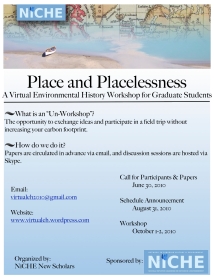 Digital technologies are changing the way we read history. With the popularization of consumer electronic e-readers like Kindle, Sony Reader, Kobo, and (yes) iPad, many textbook publishers are trying to take advantage of this opportunity to reach digital reading audiences.
Digital technologies are changing the way we read history. With the popularization of consumer electronic e-readers like Kindle, Sony Reader, Kobo, and (yes) iPad, many textbook publishers are trying to take advantage of this opportunity to reach digital reading audiences.
Unfortunately, the Kindle DX digital textbook pilot program at Princeton had a rocky start and further reviews haven’t been favourable. Some universities are now experimenting with Apple’s iPad as a digital reader for the classroom. Many of the complaints about these digital readers, however, tend to focus on the hardware and not the e-book software. Obviously the hardware plays a significant role in the digital reading experience, but it is on the software side where we are likely to see the most exciting innovation in the development of e-textbooks.
Northern Blue Publishing is a digital textbook publisher and e-learning company that seems to be making a genuine effort to harness the advantages of digital technologies for textbooks. Rather than simply replicating a print reading experience on screen, Northern Blue uses wiki-based publishing software to produce customizable textbook offerings for schools and libraries with print-on-demand, DVD or CD publishing options, and flexible licensing. This not only provides school boards and educators affordable textbooks but it uses the advantages of digital publishing over print publishing to produce a more customizable digital reading experience for teachers and students.
The History of Canada Online is one such project that illustrates many of the advantages of digital technologies for textbook publishing. Dr. Alastair Sweeny from Northern Blue answered a few questions about this project:
Sean Kheraj: What is The History of Canada Online project all about?
Alastair Sweeny: We are producing a line of digital textbooks as a business (and a passion).
SK: What are the origins of The History of Canada Online? How did this project start?
AS: It goes back to work we did in the late 1980s, specifically Canadisk, Canada’s first multimedia CD-ROM. This contained a timeline of Canadian history plus a digital library and image base, all indexed. We did it as a joint venture with Encyclopedia Britannica, who were also selling Compton’s Multimedia CD-ROM at the time.
When Britannica flamed out, due to competition from MS Encarta, we bought out their interest, continued on our own, and when teacher and McGraw-Hill author Nick Brune approached us, we pulled together a full scale online textbook portal.
SK: Who is the main audience for HCO?
AS: Middle secondary to early college. It could be used as supplement for a first year university survey course. We are doing a junior version as well. See our current line here:
http://www.northernblue.ca/products/index.php/Northern_Blue_Publishing_Portal_Index
SK: Can you explain how you are using the wiki technology for HCO?
AS: We use Mediawiki builds, but customize the software, page design and so on. It is very good, robust open source software, and it automatically indexes new pages and changes, and sends changes out as RSS if people want to subscribe.
Wikitext is fairly easy to learn and our authors are soon comfortable with writing online. Students who use Wikipedia also find it very easy to use. But under our licences, users can mix media. The NWT government for example are creating CD’s with the chapters because some of the far north village schools don’t have Web access, but they do have computers with optical drives.
SK: Where might this work go in the future?
AS: The portals are flexible and easy to update. We hope to get more and more teacher and student input in future. We are also producing ebook apps that will be free to subscribers.
Take a look at The History of Canada Online and let me know what you think. Is this a good model for textbook publishing? Do you know of other digital textbook projects doing similar work? Let me know in the comments section.
Filed under: Canadian history, Digital History, E-Books, Knowledge Mobilization, Scholarly Publishing | 5 Comments »


















